A novel role for ATM in regulating proteasome-mediated protein degradation through suppression of the ISG15 conjugation pathway
- PMID: 21298066
- PMCID: PMC3027683
- DOI: 10.1371/journal.pone.0016422
A novel role for ATM in regulating proteasome-mediated protein degradation through suppression of the ISG15 conjugation pathway
Abstract
Ataxia Telangiectasia (A-T) is an inherited immunodeficiency disorder wherein mutation of the ATM kinase is responsible for the A-T pathogenesis. Although the precise role of ATM in A-T pathogenesis is still unclear, its function in responding to DNA damage has been well established. Here we demonstrate that in addition to its role in DNA repair, ATM also regulates proteasome-mediated protein turnover through suppression of the ISG15 pathway. This conclusion is based on three major pieces of evidence: First, we demonstrate that proteasome-mediated protein degradation is impaired in A-T cells. Second, we show that the reduced protein turnover is causally linked to the elevated expression of the ubiquitin-like protein ISG15 in A-T cells. Third, we show that expression of the ISG15 is elevated in A-T cells derived from various A-T patients, as well as in brain tissues derived from the ATM knockout mice and A-T patients, suggesting that ATM negatively regulates the ISG15 pathway. Our current findings suggest for the first time that proteasome-mediated protein degradation is impaired in A-T cells due to elevated expression of the ISG15 conjugation pathway, which could contribute to progressive neurodegeneration in A-T patients.
Conflict of interest statement
Figures
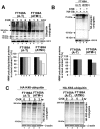
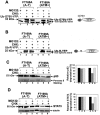
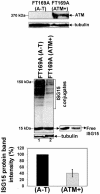
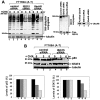


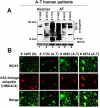
Similar articles
-
Evidence for the Deregulation of Protein Turnover Pathways in Atm-Deficient Mouse Cerebellum: An Organotypic Study.J Neuropathol Exp Neurol. 2017 Jul 1;76(7):578-584. doi: 10.1093/jnen/nlx038. J Neuropathol Exp Neurol. 2017. PMID: 28535250
-
ATM mediates repression of DNA end-degradation in an ATP-dependent manner.DNA Repair (Amst). 2008 Mar 1;7(3):464-75. doi: 10.1016/j.dnarep.2007.12.003. Epub 2008 Jan 22. DNA Repair (Amst). 2008. PMID: 18207464 Free PMC article.
-
ISG15 deregulates autophagy in genotoxin-treated ataxia telangiectasia cells.J Biol Chem. 2013 Jan 25;288(4):2388-402. doi: 10.1074/jbc.M112.403832. Epub 2012 Dec 4. J Biol Chem. 2013. PMID: 23212917 Free PMC article.
-
A multifaceted role for ATM in genome maintenance.Expert Rev Mol Med. 2003 Jun 20;5(16):1-21. doi: 10.1017/S1462399403006318. Expert Rev Mol Med. 2003. PMID: 14987398 Review.
-
Ataxia-telangiectasia mutated kinase (ATM) as a central regulator of radiation-induced DNA damage response.Acta Medica (Hradec Kralove). 2010;53(1):13-7. doi: 10.14712/18059694.2016.57. Acta Medica (Hradec Kralove). 2010. PMID: 20608227 Review.
Cited by
-
ISG15 conjugation to proteins on nascent DNA mitigates DNA replication stress.Nat Commun. 2022 Oct 10;13(1):5971. doi: 10.1038/s41467-022-33535-y. Nat Commun. 2022. PMID: 36216822 Free PMC article.
-
Single-cell RNA-seq reveals cellular heterogeneity from deep fascia in patients with acute compartment syndrome.Front Immunol. 2023 Jan 18;13:1062479. doi: 10.3389/fimmu.2022.1062479. eCollection 2022. Front Immunol. 2023. PMID: 36741388 Free PMC article.
-
In vivo effects of dexamethasone on blood gene expression in ataxia telangiectasia.Mol Cell Biochem. 2018 Jan;438(1-2):153-166. doi: 10.1007/s11010-017-3122-x. Epub 2017 Jul 25. Mol Cell Biochem. 2018. PMID: 28744812 Clinical Trial.
-
The ATM protein kinase: regulating the cellular response to genotoxic stress, and more.Nat Rev Mol Cell Biol. 2013 Apr;14(4):197-210. doi: 10.1038/nrm3546. Epub 2013 Mar 13. Nat Rev Mol Cell Biol. 2013. PMID: 23486281 Review.
-
ATM supports gammaherpesvirus replication by attenuating type I interferon pathway.Virology. 2017 Oct;510:137-146. doi: 10.1016/j.virol.2017.07.014. Epub 2017 Jul 18. Virology. 2017. PMID: 28732227 Free PMC article.
References
-
- Chun HH, Gatti RA. Ataxia-telangiectasia, an evolving phenotype. DNA Repair (Amst) 2004;3:1187–1196. - PubMed
-
- Lavin MF, Scott S, Gueven N, Kozlov S, Peng C, et al. Functional consequences of sequence alterations in the ATM gene. DNA Repair (Amst) 2004;3:1197–1205. - PubMed
-
- Boder E. Ataxia-telangiectasia: an overview. Kroc Found Ser. 1985;19:1–63. - PubMed
-
- Jentsch S, Pyrowolakis G. Ubiquitin and its kin: how close are the family ties? Trends Cell Biol. 2000;10:335–342. - PubMed
Publication types
MeSH terms
Substances
Grants and funding
LinkOut - more resources
Full Text Sources
Other Literature Sources
Medical
Molecular Biology Databases
Research Materials
Miscellaneous

